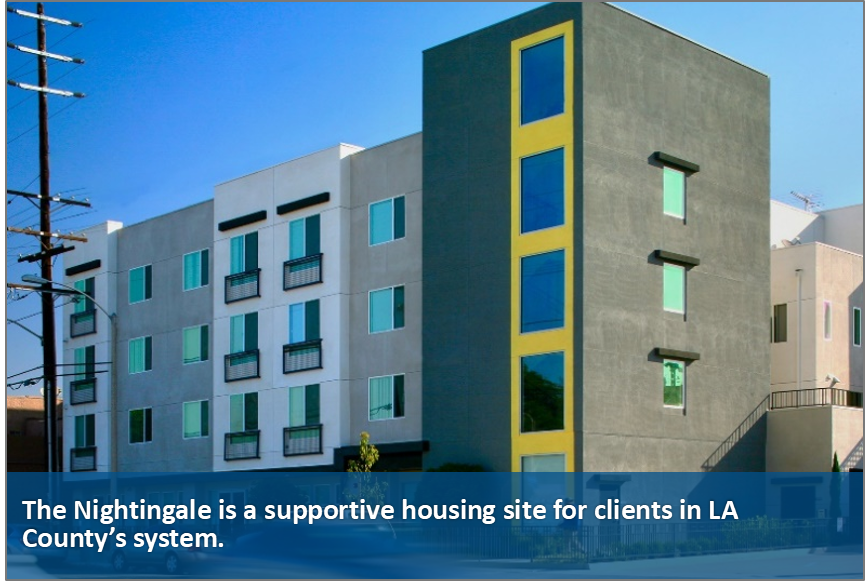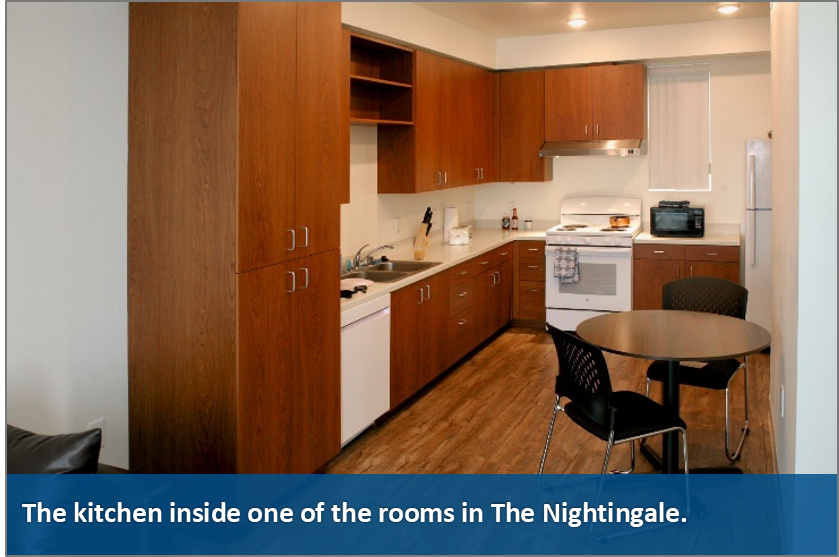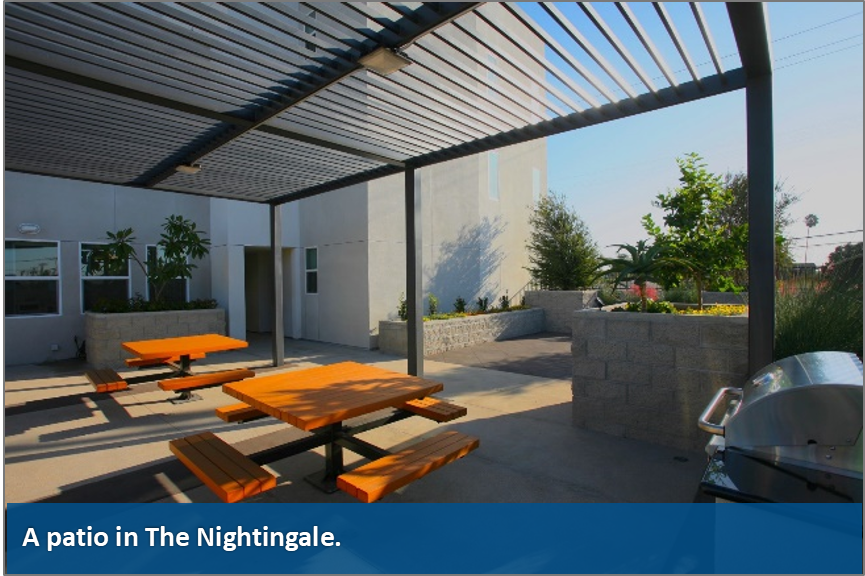
At the Center for Health Care Strategies, we strive to reflect the core values of diversity, equity, and inclusion throughout our work and in our workplace.
Name: Housing for Health
Goal: Reduce the inappropriate use of costly health care resources and improve outcomes for people experiencing homelessness and other vulnerable populations.
Featured Services: This cross-agency, county-based initiative, provides an array of integrated housing supports along with primary care and complex management services.
Target Population: Individuals experiencing homelessness in Los Angeles County.
More than 58,000 adults and children in Los Angeles County, California, are homeless on any given night and 75 percent of them do not live in homeless shelters. Instead, they are sleeping, eating, and trying to navigate their daily lives – often with medical needs or chronic health conditions – while living out in the open, in tents or in vehicles.
That’s what Jahnmaika Normil did for about 10 years. “I was living at bus stops, living in alleys. I was living wherever I could,” she says. “I refused to go to a shelter because of all the crazy stories you hear about them.” Most L.A. landlords wouldn’t rent her an apartment without a deposit of three times the monthly rental, which she could not afford. Sometimes she had enough money for weekly motel rentals, where she lived with several of her children until she could no longer pay.
That’s when she sent her children to live with relatives and tried, in her words, “to not look homeless.” Normil, who is now 52, knew which churches to go to for food and where the clothing giveaways were held. She took showers surreptitiously at a local college and slept during the day when she could, fearful of being sexually assaulted at night.
“I didn’t want to be that person downtown (in Los Angeles’ Skid Row), even though…I knew in my heart that I was,” she says. “I didn’t want to give up.”
When her chronic obstructive pulmonary disease (COPD) worsened in 2012, she qualified for supplemental security income (SSI), but the payment often only covered enough for half a month of rent. “Two weeks out of the month, I was homeless, on the street,” she says. When the Inglewood motel where she stayed closed in 2013 to make way for new development, she went to another motel for 18 months and her health deteriorated further.
“At that point, I got real sick,” says Normil, who also has high blood pressure and congestive heart failure. “My asthma got worse and I was sick with anxiety about being homeless again. I ended up going to the hospital.”
This profile is part of an ongoing series from CHCS exploring strategies for enhancing care for individuals with complex health and social needs within a diverse range of delivery system, payment, and geographic environments. LEARN MORE »
“I was living at bus stops, living in alleys. I was living wherever I could. I refused to go to a shelter because of all the crazy stories you hear about them.”
Jahnmaika Normil
Los Angeles has the second largest homeless population nationwide, after New York City. Homelessness costs L.A. about $875 million annually, in part because — as elsewhere in the United States — people with physical and/or behavioral health conditions who experience homelessness are often high users of public hospital emergency departments and inpatient care. They also may be released from hospitals back to the streets without follow-up care or supportive guidance, which often results in new medical crises for individuals and continues the cycle of high use of expensive health care services.
Recognizing the connection between stable housing and health, the L.A. County Department of Health Services (DHS) has operated a few projects over the past decade to address the needs of people experiencing homelessness who have complex physical or behavioral health conditions. By 2012, those projects included a federally subsidized, permanent supportive housing program with 200 housing units and an interim housing program that had 25 beds for people recuperating after surgery or treatment for serious illnesses. DHS also had a team-based benefits advocacy program to help eligible individuals apply for SSI or Social Security disability insurance (SSDI).
Yet it was clear that much more was needed to bring stability and better health to the many people experiencing homelessness in L.A. County.
Drawing from what was learned through its existing programs, DHS created a new division, Housing for Health (HFH). The program reflects the national movement for “housing first,” an approach that prioritizes providing individuals experiencing homelessness with housing, regardless of whether they are in treatment for their substance use, mental health, or physical health conditions (and, unlike most other housing programs outside this model, does not require sobriety as a condition of entry.) That view sees housing as necessary for the health of people experiencing homelessness. Additionally, HFH also embraces the philosophies of harm reduction, trauma-informed care, and, ultimately, “whatever it takes” to help individuals who are homeless. It incorporates these philosophies into trainings for other agencies in order to ensure that all of its housing partners are equally ready to participate in the movement to serve the most vulnerable populations experiencing homelessness with a level of dignity and care that has previously not been prioritized by the larger homeless services delivery system until now.

Dedicated to ending homelessness throughout the county, HFH also aims to reduce the inappropriate use of costly health care resources and improve outcomes for people experiencing homelessness and other vulnerable populations. The program uses an innovative integrated strategy that includes: (1) rental subsidies for affordable permanent supportive housing; (2) interim housing for people needing recovery and recuperation; (3) specialized primary care; and (4) wrap-around case management services tailored to individual needs. “Permanent supportive housing is the cornerstone of what we do and we’ve built out an entire continuum of services,” says Whitney Lawrence, HFH director of policy and planning.
Understanding the scope of the challenge, HFH found support by partnering with other public departments and agencies, nonprofit organizations, foundations, communities, private developers, and politicians.
Given the scale of the homelessness problem in the city, “We’re in a moment in Los Angeles where everyone is ready to pull up their sleeves and work together,” Lawrence says. “We all agree we can’t not do it. We have to do it, and we have to do it big.”
“Permanent supportive housing is the cornerstone of what we do and we’ve built out an entire continuum of services.”
Whitney Laurence, director of policy and planning, Housing for Health
Before HFH was launched, Mitchell H. Katz, MD, who was DHS director at the time, encouraged the small team then managing the department’s projects to take a huge leap. “He said, ‘Go ahead and do 10,000 units of housing (instead of 200),’” recalls Leepi Shimkhada, HFH director of housing and services. In the effort to reach that goal quickly, “everything exponentially scaled up as we were able to secure more funding, get more partners, and open up the pathways to do the work with our community-based homeless services providers,” Shimkhada says.
In order to achieve this rapid scaling up, HFH both developed and leveraged a number of innovative mechanisms for growing the city’s housing services. Because federal housing vouchers would not sufficiently cover 10,000 housing units, HFH created a locally funded rental subsidy program, the Flexible Housing Subsidy Pool, in 2014. The pool began with $14 million in seed funding from the county and $4 million from the Conrad N. Hilton Foundation. That money also paid for a rental subsidy provider and an agency that operates as the program’s rental subsidy administrator.
That agency, the nonprofit Brilliant Corners, develops and manages the program’s housing portfolio by recruiting landlords who have appropriate units, encouraging them to take part in the program, executing agreements, and issuing rent checks to them. It also establishes ongoing, strong relationships with landlords, provides damage mitigation, and helps enable housing for challenging patients.
Rental units are located in nonprofit-owned supportive housing, affordable housing, and private market housing, both project-based and scattered-site. Instead of preparing and signing contracts with individual landlords for thousands of tenants, HFH has one agreement, with Brilliant Corners, which handles the paperwork with landlords. HFH clients have the option to seek housing on their own because the program believes deeply in client choice, but help is always close by with Brilliant Corners and assigned case managers that understand the landscape of housing in Los Angeles County.
The source of funds that go into the Flexible Housing Subsidy Pool does not matter, says Lawrence, because all money is apportioned into housing slots. Since its inception, the pool has grown with investment from county departments, including the Department of Mental Health, the Probation Department, and the Department of Public Health. This funding enables departments and agencies to place their clients in the HFH system instead of building housing programs of their own. For example, in 2017, L.A. Care, a county-based Medicaid health plan that provides coverage to many of the county’s vulnerable and low-income communities, invested $20 million to provide permanent supportive housing for 300 of its clients.

In 2013, HFH began placing people experiencing homelessness in housing. As of October 2019, the program has clients in: 6,000 units of permanent supportive housing; interim housing in 2,300 recuperative and stabilization beds; and rapid rehousing with job training opportunities in 1,000 units. HFH also manages more than 60 street-based outreach and engagement teams; wrap-around services, including tenancy support; a countywide benefits advocacy services program (Countywide Benefits Entitlement Services Team – CBEST) co-located in 14 Department of Public Social Services offices throughout the county as well as in the jails and community-based settings; a sobering center in Skid Row; a primary care health clinic, also in the Skid Row area; and a program for people leaving jails.
Scalable contracting mechanisms are critical to HFH’s work with intensive case management services partner agencies. Instead of using a government contract with a line-item budget, which is cumbersome to scale up, HFH sets a monthly per-client fee of $450 for Intensive Case Management Services (ICMS) in the permanent supportive housing program. ICMS providers maintain a ratio of one case manager to 20 clients, and scale up by 20 clients at a time by hiring additional managers. “That makes it formulaic and easy for us to administer,” Lawrence says. HFH is also working with contracted providers to bring relief to their staff by allowing the intensity of services to scale down as individuals stabilize over time in permanent housing. Under this arrangement, services can be delivered at a low acuity level for $225 per client per month and with a caseload ratio of one case manager to 40 clients.
HFH’s continued growth is now benefitting from the passage of Measure H, a quarter-cent sales tax that went before Los Angeles voters in 2017 to fund homeless services. The measure had wide political and community support, and won almost 70 percent voter approval.
Measure H will generate a huge injection of funding – $355 million annually for 10 years – specifically earmarked for programs and services to help those experiencing homelessness. This added funding resource has allowed HFH to expand its permanent supportive housing program by 2,500 slots in 2018, the first year that funds from the tax were received. The measure also helped HFH broaden its network of referral sources for connecting with people experiencing homelessness.
HFH takes part in a coordinated entry system (CES) for those applying for homeless services from sources including hospitals, agencies, and partner organizations. Housing need is assessed with a HUD-approved triage tool, based on health conditions, length of homelessness, and other factors. HFH is the high acuity services arm of the Los Angeles CES and receives clients directly from a community queue maintained by the Los Angeles Homeless Services Authority.

During her hospital stay in 2016, Normil heard about HFH, and applied with the help of the hospital social worker. Because she still needed some medical care, she was first placed in HFH’s interim housing program. The hospital that she was discharged from helped place her in the recuperative care housing at HFH’s Martin Luther King Jr. Recuperative Care Center in South L.A. She was given clinical care and oversight, the room she shared with another patient was cleaned regularly, and she had three meals daily.
At first, Normil was worried by her surroundings and the services being provided. “In my head, being on the street, I was like, ‘Are they going to do experiments on me?’” When she finally trusted the program, “It blew my mind,” she says. “These people were super nice to me. I couldn’t believe it…they know that I’m homeless, but they’re actually helping me!”
She was in the recuperative care center for nine months and then moved on to an HFH rent-subsidized, two-bedroom townhouse in Gardena with three of her children. She has lived there since mid-2017.
A 2017 RAND analysis of 890 HFH clients showed that 83 percent were chronically homeless by HUD’s definition, and that 88 percent had a co-occurring medical and mental health or substance use condition. More than 96 percent of the HFH clients surveyed had been in stable housing for at least one year at the time of the survey, illustrating the program’s success rate.
Whole Person Care–Los Angeles (WPC-LA), an initiative funded by a Section 1115 Medicaid demonstration waiver that focuses on coordinating medical, behavioral health, and social services, gives additional care management and coordination services to homeless Medi-Cal beneficiaries served by HFH. Through the waiver grant program, WPC-LA has helped HFH accelerate and expand its activities.
“We were able to fund [HFH’s] growth before the county passed Measure H,” says Clemens Hong, MD, MPH, director of WPC-LA and medical director of community health improvement for DHS. When Measure H funds became available, they went to HFH as a housing subsidy, he explains. WPC-LA matched that with service dollars for health promotion, intensive case management, and capital to build and strengthen infrastructure in data analytics, recuperative care, and more.
WPC-LA now helps fund services for five HFH programs: permanent supportive housing, a sobering center, two interim housing programs, and the Countywide Benefits Entitlement Services Team (CBEST). The initiative has also shared expertise, such as a formal process for enrolling people in Medicaid, and will help HFH deploy protocols for hospital-to-home health promotion that could reduce hospital readmissions.
Homelessness and its related health problems challenge communities nationwide. As in L.A., programs to address homelessness can benefit from engaging public, nonprofit, and private resources, as well as community activism and political will.
In the six years since it began, HFH has built partnerships with more than 70 social service and health agencies across L.A. County. These organizations help with everything from benefits to recovery services through CBEST, housing location, and ongoing retention services through HFH’s intensive case management services program. Several organizations have supported HFH’s activities, including the Conrad N. Hilton Foundation, UniHealth Foundation, Weingart Foundation, California Community Foundation, and L.A. Care Health Plan. And now, according to Shimkhada, Measure H tax funds from L.A. residents will support about 80 percent of HFH’s growth in the next five years.
The HFH experience can help similar projects elsewhere, even in smaller communities. Here are several suggestions from lessons learned by the L.A. effort:
According to Dr. Hong, WPC-LA chiefly serves individuals who are in recovery from mental health conditions, substance use disorders, or trauma. “When you think about a recovery framework . . . a key part is having a secure base,” he says. As an example, Dr. Hong notes that teaching about diabetes self-management would not be effective if the person with diabetes has no established home and no refrigerator for storing insulin.
“’Housing first’ is really the foundation of providing complex care for individuals who are homeless,” he says.
“I’m so grateful to have a place that my kids can come to, that I can be able to cook for them and be here after school… Without this program, we’d still be homeless, and that’s a scary thing.”
Jahnmaika Normil
Since moving to permanent supportive housing with HFH’s help in 2017, Normil’s asthma attacks have lessened, from four to one per day, and her frequent coughing has abated.
“I can walk from here around the corner to the store, without passing out,” she says. She also no longer has bouts of severe anxiety.
The RAND analysis found that, in the year after housing placement, HFH clients showed a:
After accounting for the costs of permanent supportive housing for those individuals, the reductions represented a 20 percent net cost savings for L.A. County.
“Now I’m much better,” says Normil. “I’m so grateful to have a place that my kids can come to, that I can be able to cook for them and be here after school, even though they drive me nuts,” she says, with a laugh. “Without this program, we’d still be homeless and that’s a scary thing.”
he Center for Health Care Strategies (CHCS) is a nonprofit policy center dedicated to improving the health of low-income Americans. It works with state and federal agencies, health plans, providers, and community-based organizations to develop innovative programs that better serve people with complex and high-cost health care needs. To learn more, visit www.chcs.org.
Housing for Health is part of the Complex Care Innovation Lab (CCIL), a national initiative led by CHCS through support from Kaiser Permanente Community Health and the Robert Wood Johnson Foundation. Since 2013, CCIL has brought together leading innovators from across the country who are focused on improving care and outcomes for low-income individuals with complex medical and social needs. For more information, visit www.chcs.org/innovation-lab/.
Author Robin Warshaw is an award-winning writer who focuses on medicine, social issues, and health care.